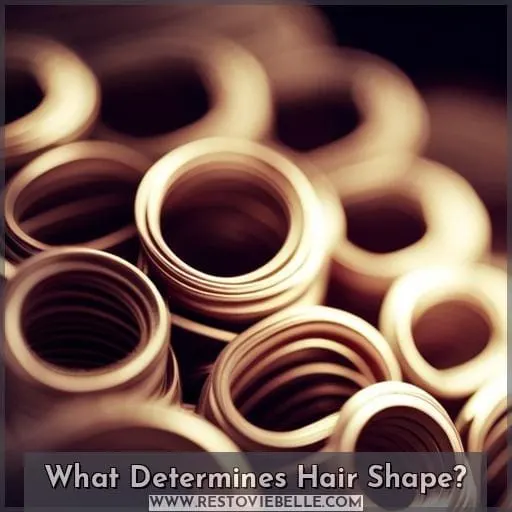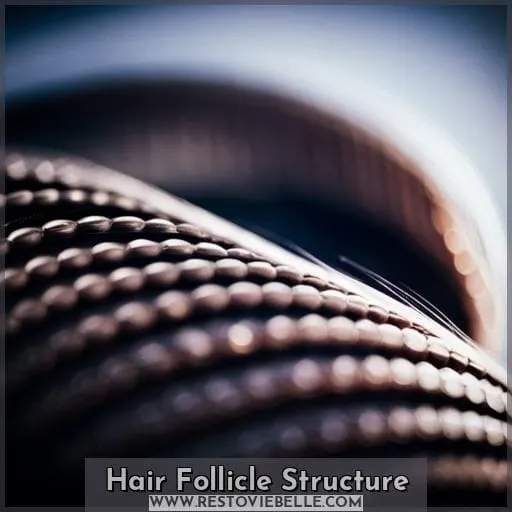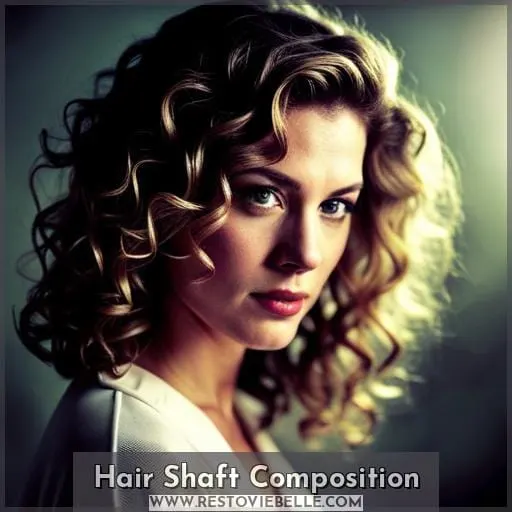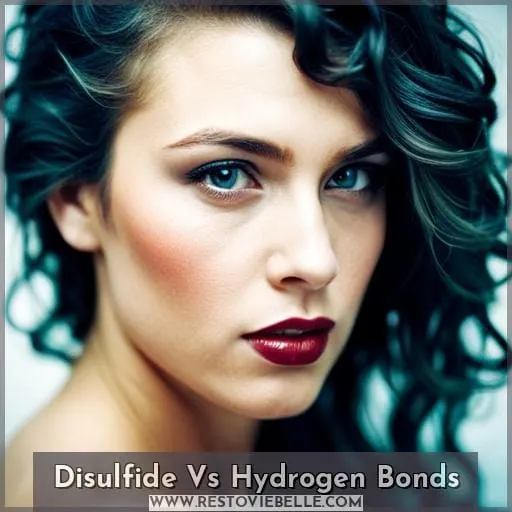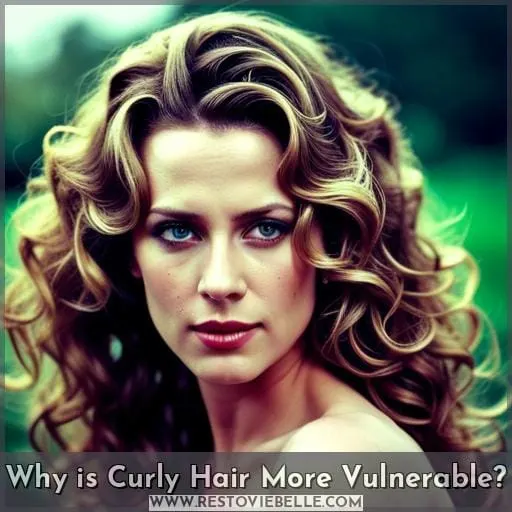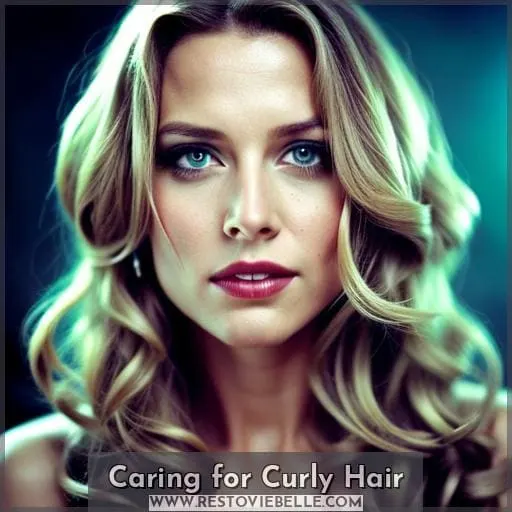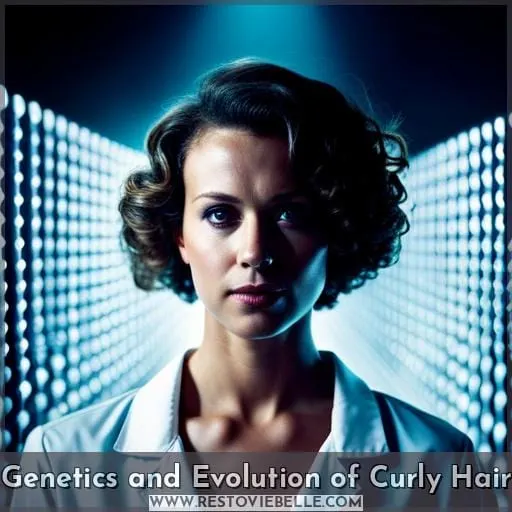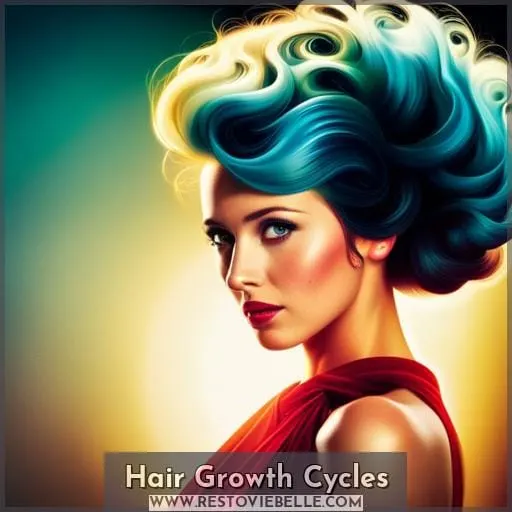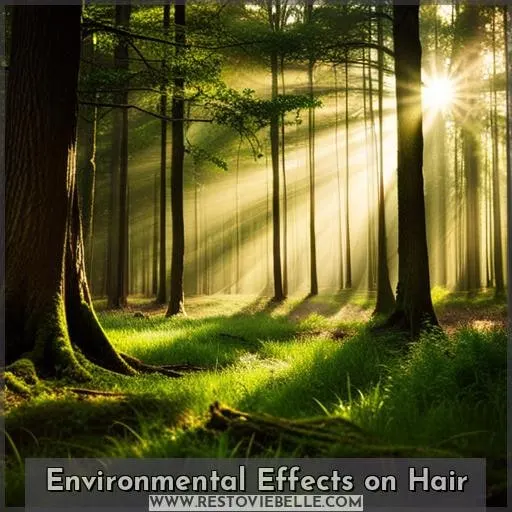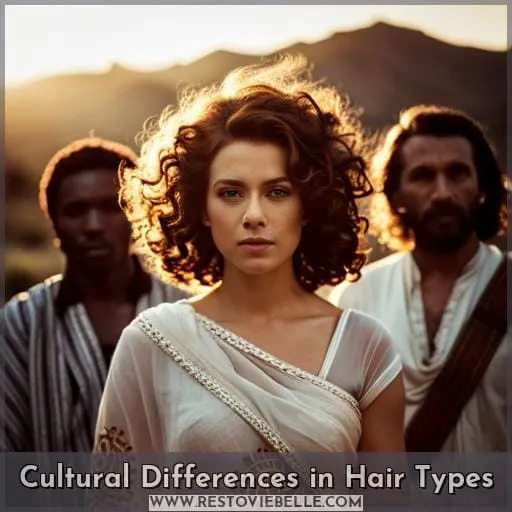This site is supported by our readers. We may earn a commission, at no cost to you, if you purchase through links.
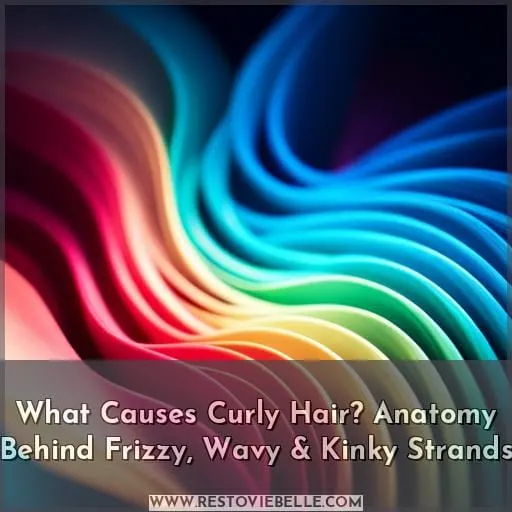 You’ve probably wondered what makes your hair so delightfully curly or frustratingly frizzy. The answers lie within your hair’s anatomy. Your strands’ shape arises from your hair follicles’ form and your hair shaft’s composition.
You’ve probably wondered what makes your hair so delightfully curly or frustratingly frizzy. The answers lie within your hair’s anatomy. Your strands’ shape arises from your hair follicles’ form and your hair shaft’s composition.
Oval-shaped follicles beget curly tresses, while round follicles birth straight hair. Meanwhile, the quantity and placement of bonds along each hair’s shaft determine curl intensity. Don’t fret over unruly curls; your hair’s natural texture results from the fascinating biology within.
Table Of Contents
Key Takeaways
- Curly hair follicles have a unique twisting structure that leads to curl formation.
- Multiple genes, like the trichohyalin (TCHH) gene, cooperate to produce curly hair textures.
- Humidity affects the hydrogen bonds in curly hair, leading to frizz in humid climates.
- The genetics of curly hair originate from African ancestry and provide evolutionary benefits.
What Determines Hair Shape?
Your hair shape was set during embryonic development based on the curvature of your individual hair follicles. Genes play a crucial role in determining if your hair is straight or curly. Variants in the trichohyalin (TCHH) gene are associated with different hair shapes across populations.
Differences in cell behavior as hair fibers are produced also contribute to your genetically-programmed hair shape. While environmental factors can temporarily alter your hair, the inherent curvature of each follicle remains unchanged.
Your hair texture results from complex genetic factors established before birth interacting with temporary influences after birth. Ultimately, the shape of your hair follicle dictates if you’ll have straight, wavy, or curly hair.
Hair Follicle Structure
The uniquely shaped curly hair follicle establishes your distinctive curl pattern. Hidden beneath the surface, the twisting, curving structure of each hair follicle imprints its form on strands sprouting forth.
During early development, intricate genetic coding directs cells to construct the S-shaped passages. DNA provides the architectural plans, but environmental influences fine-tune the ultimate blueprint.
As follicles regenerate in cyclical hair growth, the pathway curvature remains imprinted.
The mysteries of genetic and molecular regulators enabling follicles to recreate their signature twists and coils still evade researchers. Unraveling the intricate biology underpinning follicle architecture could illuminate the fundamental processes guiding human development.
While the origins of your unique ringlets remain enigmatic, embrace the beauty of naturally textured tresses growing from follicles formed just for you.
Hair Shaft Composition
Hair Shaft Composition
As your hair grows out of the follicle, its internal structure determines the shape, strength and integrity of each strand.
- The medulla is the soft, innermost layer. This core may be absent in fine or curly hair.
- The cortex forms the bulk of each hair strand. Composed of keratin proteins held together by strong disulfide bonds, the cortex provides structure and elasticity.
- The cuticle is the protective outer layer, with overlapping scales that defend against damage.
Understanding the architecture built into your hair allows you to care for it properly. With curly hair’s natural fragility, be gentle in handling and minimize damage from styling.
Disulfide Vs Hydrogen Bonds
Y’ain’t a perm: curly hair’s coiled springs owe stiffness to disulfide, flexibility to hydrogen bonds. Those intricate ringlets and tight coils in your curly mane arise from a snakelike, S-shaped follicle.
While the follicle’s curves are fixed from the start, the chemical bonds in your hair strands respond to weather.
Disulfide bonds between sulfur atoms lend strong stiffness. Meanwhile, temporary hydrogen bonds with water molecules let those coils flex and frizz up in humidity’s embrace.
So while genetics decree the curviness of your follicles, it’s chemistry that brings out curls’ can’t-resist-me bounce and touchable texture. With the right care, you can define your strands and let your inner spring shine through.
Embrace the bonds!
Why is Curly Hair More Vulnerable?
Y’all’s curly hair’s more vulnerable ’cause of its unique structure:
- More prone to tangles and knots
- More exposed cuticle
- More affected by humidity
- Prone to frizz and dryness
The curvy shape of the follicle produces curly strands with bends and kinks. This makes the cuticle of curly hair more exposed. The curly shape also causes hairs to tangle and knot more easily. When humidity enters the hair shaft, curly hair is more affected.
The hydrogen bonds that give curly hair its bend become disrupted. This leads the curls to frizz and lose definition.
To prevent damage, be gentle when brushing. Use protective styles, deep conditioning treatments and anti-frizz products. Work with your curl’s natural texture, enhancing its beauty. While shaped by your genetics, give your locks some extra TLC.
Caring for Curly Hair
Curly hair needs specialized care and attention to stay healthy. To keep your curls hydrated and smooth, use moisturizing treatments like hot oil and medicated shampoos. Combat dry scalp and dandruff with exfoliating sugar scrubs and soothing tea tree oil.
Using conditioner and leave-in treatments will help define your curls and prevent frizz. When styling, scrunch in curl cream or mousse and let your hair air dry to enhance your natural texture. At night, protect curls by loosely tying your hair up in a satin scarf or bonnet.
With the right techniques, you can help your curly locks look bouncy and beautiful.
Moisturizing
You’re seeking hydrating products for your curls since curly hair tends to dryness.
| Hydration Method | Benefit |
|---|---|
| Leave-in conditioner | Seals moisture into hair cuticles |
| Deep conditioning | Restores moisture balance |
| Leave-in cream | Defines curls, controls frizz |
| Oils | Seal in moisture, add shine |
Pair hydrating products with gentle handling, like brushing wet hair. This prevents raising the cuticle and causing frizz. Embracing your curls means understanding and caring for their unique moisture needs.
Dandruff Management
Sugar scrubs combat those dry flakes fast, keeping your scalp refreshed.
- Sea salt
- Coconut oil
- Baking soda
- Apple cider vinegar
Less frequent shampooing and using sulfate-free formulas help. Gently massaging medicated shampoo into your scalp can also help. Applying oil to your scalp before washing is another trick. Letting your curls air dry instead of rubbing with a towel prevents irritation.
Genetics and Evolution of Curly Hair
Hon, your hair’s curliness has deep roots in your genes passed down through generations. Curly hair genetics arise from Africa, where humans first evolved. Certain gene variations in African populations influence hair structure and curl.
This likely helped ancient humans adapt to warm climates, as curly hair aids cooling.
Now, curly hair genetics often follow standard inheritance rules. The curlier hair trait tends to be dominant. Specific genes like trichohyalin contribute by affecting hair follicle shape during development.
Though the genetics aren’t fully mapped out, multiple genes certainly cooperate to produce curly tresses.
Hair Growth Cycles
Each strand cycles through growth phases over years yet always regenerates its innate curve through the mysteriously curving follicles.
- Anagen phase (2-6 years) – active hair growth
- Catagen phase (2-3 weeks) – hair follicle shrinks
- Telogen phase (2-3 months) – resting, hair shedding
- Exogen phase – hair shedding completes
Caring for your curly locks through each cycle with hydrating masks and gentle handling maintains their health. Although the genetics behind curly hair’s regrowth remain elusive, embrace your ringlets knowing they’ll curl anew again.
Regular trims keep split ends at bay. Understanding hair’s phases empowers and enriches your spirals’ lifelong journey.
Environmental Effects on Hair
You’d have curlier hair if you lived in a more humid climate. The moisture in the air causes the strands to swell, creating more texture and wave. Those residing in tropical locales often sport lush spirals while desert dwellers have sleek tresses.
Many African groups refrain from chemical straighteners, allowing their glorious kinks to shine.
Temperature extremes either way can compromise follicular health, spurring damage or irregularities.
Cultural Differences in Hair Types
You’ve gotta see the mind-blowing cultural differences in hair types across the globe! Different regions have unique haircare practices, styling trends, and perceptions shaped by cultural influences.
- African hair braiding dates back 5,000 years with spiritual meaning.
- Asian hair is often tied back or covered for modesty.
- Vikings associated long hair with honor and freedom.
Hair diversity stems from adaptations to climate, genetics, and cultural preferences over time. Understanding the historical significance and cultural pride around hair types builds appreciation for all hair textures.
Conclusion
You determine the shape of your locks. The structure of your hair follicles, established before birth, dictates if your strands will be straight or curly. Keratin composition and disulfide bonds make curly hair prone to tangles. Yet, with the proper care like gentle brushing, moisturizing, and embracing your natural texture, you can have healthy, defined curls.
Genetics determine what causes curly hair. However, how you nurture your coils makes all the difference.
